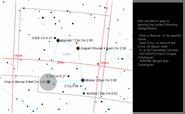
After the stars be designated by names, and even if the Ptolemy's catalogue, part of the Almagest, was listing about 1,000 stars as varied names for a same bright star remained along centuries. The first system of modern era was the one of the German astronomer Johann Bayer in 1603. The advance of science at the Renaissance made that a universal cataloguing system became needed to name bright stars the same name whatever the nation of astronomers. Stars with Bayer, in each constellation, were designated by a lower case Greek letter. Attribution was made more or less in order of brightness although Bayer also often took in account the star's position in the constellation (a bright star located more southerly in a constellation could be named with a late letter of the Greek alphabet). This originated the classical way of designating stars: a Greek letter and the constellation's Latin name genitive abbreviation. Procyon, main star of Canis Minor, the Little Dog, is thus named "a CMi", that is "a Canis Majoris", i.e. "alpha of Canis Major, the Little Dog". about constellations abbreviations see the tutorial "Constellations Latin Names, Abbreviations and Genitives". Once the 24 letters of the Greek alphabet exhausted, Bayer used lower and upper case Roman letters for the stars numbered 25 to 50 and 51 to 76 respectively in each constellation as that system was used too by other cartographers who used capital letter Roman letters too. Most of such designations are no more in use today. They may be seen for some southern hemisphere stars. To compensate for the limited number of Greek letters, Bayer added superscripts to a Greek letter too, thus designating some stars located near one another (d1, d2, d3 of Taurus, the Bull e.g.). As the techniques of observation progressed --and the stars' count -- English first Royal Astronomer John Flamsteed began to use serial numbers about 1712. Serial numbers were applied to stars, in each constellation, according to the position of them in right ascension (R.A.), from West to East. Westernmost star was "1", next "2", etc. Thus two bottom stars of Gemini, the Twins are "13" and "24" as Castor and Pollux are "66" and "78". Brightest stars were remaining named by their usual name, as did stars attributed with a Greek letter. Flamsteed numbers were used mostly about stars Bayer had named with Roman letters. We now know that the Flamsteed numbers were not actually allocated by Flamsteed himself but by a French astronomer, Jérôme Lalande, in a French edition of Flamsteed’s catalogue published in 1783
 | click to a view of stars' designations in constellation of Corvus, the Crow (chart Cartes du Ciel, Patrick Chevalley) |
Astronomical science progressing again, telescopes allowing to see more and more stars, the German astronomer F.W.A. Argelander, from the Bonn observatory, began in 1859 a gigantic stars list. Any consideration of constellations was dropped and stars were just considered according to their position. The "Bonner Durchmusterung" (BD) lists stars down to 10th magnitude on the basis of declination stripes 1° wide, circling the 24 hours of right ascension. In each strip stars are attributed serial numbers from West to East, based on their R.A. Beyond 2° South of celestial equator, the Bonner Durchmusterung was complemented by the SBD or 'Cape Durchmusterung' (for the southern hemisphere), then the Cordoba Durchmusterung (CD, or CoD). The BDs remained astronomers' tool during a century. Names in the Durchmusterungs are the catalogue abbreviation (BD, SBD, etc) followed by the strip declination, and the star range in the latter. E.g. Vega is "BD+38°3238" or Canopus "CD-52°914" (the 3238th star in the 38-39° North declination strip or the 914th star in the 52-53° South declination strip respectively). Next important work was the Henry Draper Catalogue. At the origin it was a specialty catalogue, aiming at cataloging spectral classes of 300,000 stars. The Henry Draper Catalogue was compiled in the 1910s by Annie J. Cannon, a female astronomer at the Harvard College Observatory. More stars were added in the Henry Draper Extension (1949). The Henry Draper catalogues list stars down to 10th magnitude, stars being attributed serial numbers eastwards from the vernal equinox with no consideration about declination. Stars designation are thus of the style "HD 172167" or "HDE 256943". Such names are used for stars which neither Bayer nor Flamsteed named. Meanwhile, another catalogue had been issued at Harvard: the Revised Harvard Photometry, 1908, purpose of which was to give precise magnitudes for the brilliantest 9110 stars, down to magnitude 6.5. This catalogue remains the basis of the modern, Yale, "Bright Star Catalogue" (1966, Harvard). The "Bright Star Catalogue" is much used today. As first produced at Harvard, stars designations are of the type "HR 7001" e.g. where "HR" stands for "Harvard Revised". Stars are catalogued from West to East, based on their R.A., beginning at R.A. zero. The 'Positions and Proper Motions Catalogue' (PPM) is also of note. That multiplicity of catalogues along with those following brought a multiplicity of designations for a same star
Some specialized catalogues, like a conclusion, are, for example, the Aitken for double stars (ADS), or the Gliese (Gl, GJ, CNS) for all stars within 25 parsecs of Earth
Website Manager: G. Guichard, site 'Amateur Astronomy,' http://stars5.6te.net. Page Editor: G. Guichard. last edited: 12/26/2016. contact us at ggwebsites@outlook.com